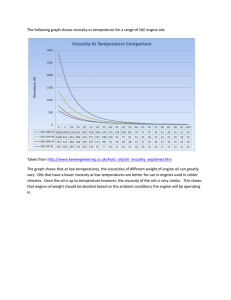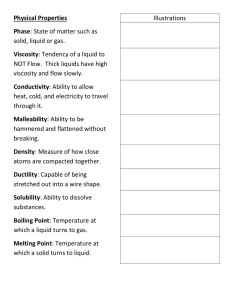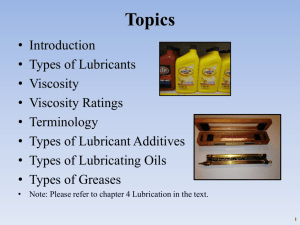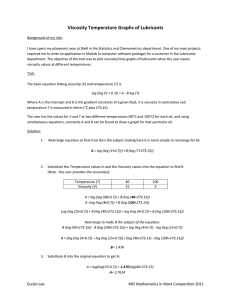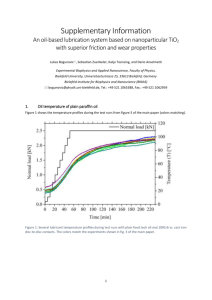Lubricant Challenges in Extreme Cold Environments
advertisement
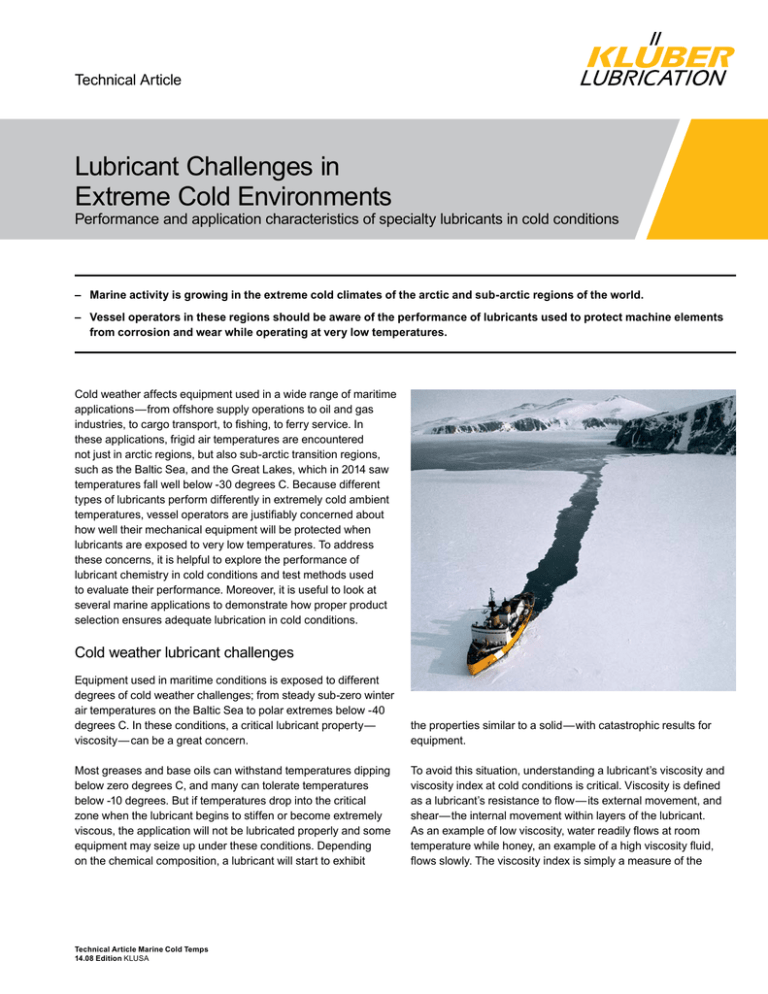
Technical Article Lubricant Challenges in Extreme Cold Environments Performance and application characteristics of specialty lubricants in cold conditions –– Marine activity is growing in the extreme cold climates of the arctic and sub-arctic regions of the world. –– Vessel operators in these regions should be aware of the performance of lubricants used to protect machine elements from corrosion and wear while operating at very low temperatures. Cold weather affects equipment used in a wide range of maritime applications—from offshore supply operations to oil and gas industries, to cargo transport, to fishing, to ferry service. In these applications, frigid air temperatures are encountered not just in arctic regions, but also sub-arctic transition regions, such as the Baltic Sea, and the Great Lakes, which in 2014 saw temperatures fall well below -30 degrees C. Because different types of lubricants perform differently in extremely cold ambient temperatures, vessel operators are justifiably concerned about how well their mechanical equipment will be protected when lubricants are exposed to very low temperatures. To address these concerns, it is helpful to explore the performance of lubricant chemistry in cold conditions and test methods used to evaluate their performance. Moreover, it is useful to look at several marine applications to demonstrate how proper product selection ensures adequate lubrication in cold conditions. Cold weather lubricant challenges Equipment used in maritime conditions is exposed to different degrees of cold weather challenges; from steady sub-zero winter air temperatures on the Baltic Sea to polar extremes below -40 degrees C. In these conditions, a critical lubricant property— viscosity—can be a great concern. the properties similar to a solid—with catastrophic results for equipment. Most greases and base oils can withstand temperatures dipping below zero degrees C, and many can tolerate temperatures below -10 degrees. But if temperatures drop into the critical zone when the lubricant begins to stiffen or become extremely viscous, the application will not be lubricated properly and some equipment may seize up under these conditions. Depending on the chemical composition, a lubricant will start to exhibit To avoid this situation, understanding a lubricant’s viscosity and viscosity index at cold conditions is critical. Viscosity is defined as a lubricant’s resistance to flow—its external movement, and shear—the internal movement within layers of the lubricant. As an example of low viscosity, water readily flows at room temperature while honey, an example of a high viscosity fluid, flows slowly. The viscosity index is simply a measure of the Technical Article Marine Cold Temps 14.08 Edition KLUSA Technical Article Lubricant Challenges in Extreme Cold Environments Performance and application characteristics of specialty lubricants in cold conditions rate of change in viscosity as the temperature changes. As temperatures increase, the viscosity of an oil drops and it flows more readily. As temperature decreases, the viscosity can rapidly increase to the point where the oil will no longer flow. The higher the viscosity index, the lower the rate of change in viscosity as temperatures change. Low-temperature properties of base oils, thickeners and additives In most cases, it is recommended that high viscosity index oils be considered for cold temperature operation. However, it is important to understand that selecting a lubricant with a high viscosity index is not always the best solution to low-temperature problems. That’s because lubricating oil is composed of one or more base oils, plus additives. Each component affects low-temperature performance. For example, engine oil labeled 5w-30 has viscosity modifiers that allow the oil to perform like lower weight oil in cold weather and higher weight oil once the engine comes up to speed. But with marine lubricants used on deck gears, hydraulic systems, and various deck applications, viscosity improvers are generally avoided, because they can impact other properties of the lubricant. Therefore, the proper selection of the base oil is important. There are five types of base oil; refined mineral oils, synthesized PAOs (polyalphaolefin), PAGs (polyalkylene glycol), Esters (natural or synthesized), and PFPEs (perflourinated polyether). Each type offers different cold weather properties as summarized (Table 1). Lubricating greases are a combination of one or more base oils and a thickener plus additives. As with base oils, lubricating greases that exhibit temperature stability also provide excellent low-temperature performance. In practice, greases that use base oil at temperatures lower than the pour point of the base oil can sometimes function as long as the grease doesn’t solidify. Why? Because friction at the point of tribological contact (the lubrication point) increases grease temperature sufficiently to maintain lubrication. As with lubricating oils, the choice of thickeners can impact cold weather performance (Table 2). Typical grease thickeners are lithium soap, aluminum soap, calcium soap, barium soap, and PTFE (polytetraflouroetheylene also known as silicon). Commonly, grease that shows good low-temperature stability Table 1: Cold weather properties of base oils Technical Article Marine Cold Temps 14.08 Edition KLUSA Base Oil Viscosity Index Pour Point Mineral Oil 80 - 100 Poor low temperature behavior PAO 150 - 250 Good low temperature behavior -40 to -50 C Esters 140 - 175 Excellent low temperature behavior -50 C or below PAG 150 - 270 Good low temperature behavior -40 to -50 C Silicone Oils 190 - 500 Excellent low-temperature behavior -50 C or below PFPE 50 - 350 Some types can go as low as -70 C (temperature below which the oil does not flow by itself) Table 2: Cold weather properties of greases Lower Service Levels (Celsius) Oil Type Li Al Na Ca Ba Pu PTFE Mineral -10 to -35 -10 to -30 -20 to -30 -10 to -30 -10 to -20 -10 to -35 Not Common PAO -25 to -50 -25 to -50 Not Common -35 to -50 -35 to -50 -20 to -40 -20 to -50 Ester -40 to -70 Not Common Not Common -20 to -40 Not Common -10 to -50 Not Common PAG -30 to -50 Not Common Not Common Not Common Not Common Not Common -20 to -30 PFPE Not Common Not Common -25 to -40 Not Common Not Common Not Common -20 to -70 Silicone -40 to -50 Not Common -30 to -60 Not Common Not Common Not Common -40 to -70 will often perform poorly in high-temperature applications— requiring grease change out in warmer weather. Moreover in maritime applications, some additives have a negative environmental impact. To evaluate cold-weather performance, several standard test methods are applied to measure a number of critical properties. The pour point test determines the lowest temperature at which oil, chilled under test conditions, will still flow—an indication of the lowest temperature at which oil is still pumpable. Flow pressure tests determine the amount of pressure required at a given temperature to make a grease flow within the system—providing indications of the energy required to pump or otherwise apply the lubricant. A low temperature torque test is used to measure the extent to which a grease retards rotation of a bearing assembly at the test temperature. Insight from maritime applications at low temperatures Latches, hinges, moving parts on deck: On an icebreaker working in artic and sub-arctic temperatures, every moving part on the deck of the ship—from hinges to valve stems to wire rope sheaves—has to continue to operate in cold weather. When moving deck applications stick or freeze, and when ice builds up on valves, operation is not only difficult, it can Technical Article Marine Cold Temps 14.08 Edition KLUSA A working vessel with numerous lubricating needs on deck. be dangerous. In this case, the solution for pins, plain and rolling bearings, and valve stems was applying Klüber ISOFLEX TOPAS NB 52, a PAO-based grease with a barium complex that has a wide temperature range. For this application, the grease was dispensed from an aerosol can—a convenient method of application to keep machinery running smoothly and allow ice to be chipped off easily. Technical Article Lubricant Challenges in Extreme Cold Environments Performance and application characteristics of specialty lubricants in cold conditions Hydraulic cranes on docks: For a Canadian fuel dock, changing from a medium viscosity mineral-based hydraulic fluid in summer to a lower viscosity fluid in winter was being considered—plus using mineral oil raised environmental concerns. The solution was Klüberbio LR 9-46, an environmentally acceptable synthetic ester-based hydraulic fluid that is readily biodegradable. It has a high viscosity index allowing it to be used in both seasons, keeping costs down while meeting application and environmental concerns. Anchor-winch handling: For one customer operating highly loaded shipboard winches in cold weather, the challenge was to find a lubricant that could handle the forces at different temperatures to avoid premature gear wear. The recommended winter solution was to switch from using Klüberfluid CF3 Ultra—a transparent adhesive lubricant designed for medium-size to large girth gear drives—to Klüberfluid CF4 Ultra, which has a lower viscosity that delivers better pumpability in spray lubricators during cold weather. Jack-up legs: For one customer operating an oil rig installation vessel in the North Sea, jack-up gears are used to raise and lower legs onto the sea bed to lift vessels out of the water. The lubricant grease that is applied to the legs must remain pumpable at low temperatures. And because the grease is washed away in sea water, it must also be environmentally compliant. The solution was Klüberbio LG 39-700, an eco-compatible adhesive lubricant specifically designed for this application using a base oil derived from 100 percent renewable resources that are acceptable for contact with sea water. The grease was applied by an automatic paddle applicator. Different lubricants for different low-temperature applications In recent years, research and development in lubricants for extremely cold marine conditions has resulted in a host of lubricants and greases with ideal properties, including numerous environmentally acceptable products. To ensure cold-weather performance, the user can consult the testing data available from reputable manufacturers. Operators also have more applicator options, including heaters, larger feed lines, elbows, automatic paddles, single-point lubricators, and pumps, as well as spray and brush applications. Where specific challenges arise, specific formulations can be selected using base oils, thickeners and additives to ensure satisfactory lubricant performance in practically every climate. For more information, please contact Klüber Lubrication at marketing@us.kluber.com Klüber Lubrication, N.A. / 32 Industrial Drive / Londonderry, NH 03053 / Toll Free: 1-800-447-2238 / Phone: 603-647-4104 / Fax: 603-647-4106 Innovative tribological solutions are our passion. Through personal contact and consultation, we help our customers to be successful worldwide, in all industries and markets. With our ambitious technical concepts and experienced, competent staff we have been fulfilling increasingly demanding requirements by manufacturing efficient high-performance lubricants for more than 80 years.
